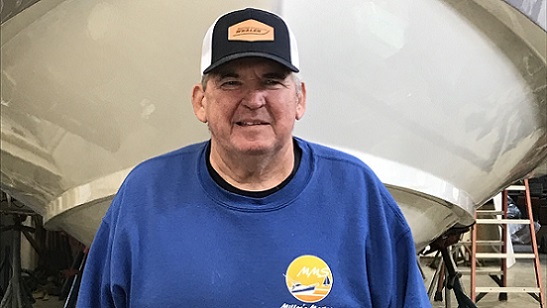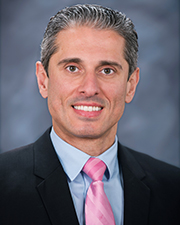Clinical Trial Aids Chestertown Man in Beating Aggressive Cancer

Rick Miller stands in front of one of the boats in his workshop at Miller’s Marine Services in Chestertown. Thanks to the support of his wife, Diana Miller, a successful surgery at University of Maryland Shore Medical Center at Easton, an innovative clinical trial, and advanced cancer care at University of Maryland Marlene and Stewart Greenebaum Comprehensive Cancer Center, Miller is living cancer-free.
When Chestertown native Rick Miller began exhibiting puzzling and severe symptoms — fainting spells, changes in his speech and behavior, trouble walking, migraines and periods of confusion — he and his wife, Diana Miller, knew that he would likely require highly specialized care. The 61-year-old was ultimately diagnosed with aggressive brain cancer and received a combination of surgery and cancer treatments, thanks to the coordinated efforts of physicians within the University of Maryland Medical System (UMMS).
Miller's journey began in 2019 in the Emergency Department of University of Maryland Shore Medical Center at Chestertown, where his wife had formerly worked as a critical care nurse. After undergoing emergency brain surgery at UM Shore Medical Center at Easton, Miller was treated in an innovative clinical trial at the University of Maryland Medical Center in Baltimore, led by Graeme Woodworth, MD, FACS. Nearly four years later, Miller remains cancer-free.
Through its affiliation as a member organization hospital of UMMS, UM Shore Regional Health physicians benefit from the academic health System's focus and pursuit of innovation and discovery-based medicine.
On that night in March 2019, during the initial trip to the hospital in Chestertown, Miller couldn't have known where his journey back to health would take him. After quickly ruling out a cardiac issue, the emergency care team rushed him in for a cranial CT scan, where they discovered a 5-centimeter lesion on the right side of his brain.
Emergency Department physician Steven Lucas, MD, sent Miller's CT slides to UM SRH neurosurgeon Khalid Kurtom, MD, FAANS, FACS, for review. Dr. Kurtom is on-call 24/7/365 for neurological and spinal consultations requested by UM SRH emergency departments in Cambridge, Chestertown, Easton and Queenstown. He quickly recognized the source of Miller's symptoms: a glioblastoma, which is a malignant or cancerous tumor affecting the brain or spine, and directed Miller to be transferred to UM Shore Medical Center at Easton for emergency surgery.
"You could see the tumor pushing and crowding Rick's brain," Diana Miller said.
Once Miller arrived, Dr. Kurtom needed to make sure some of the swelling in Miller's brain was reduced before he could safely perform the surgery. Three days later, Dr. Kurtom performed a craniotomy mass resection, a surgical procedure in which part of the skull is removed in order to view the brain, and also a gross total resection to remove the tumor.
"The main goals of this type of surgery are to obtain tissue for diagnosis, remove pressure from the brain and to improve the patient's prognosis," said Dr. Kurtom, who joined UM Shore Regional Health in 2010 and now serves as Medical Director, UM Shore Medical Group – Neurosurgery, Chair of the UM SRH Surgical Department, Adjunct Associate Professor with the University of Maryland School of Medicine (UMSOM), and the Regional Chief of the University of Maryland Neuroscience Network.
The surgery was performed with minimal tissue disruption through a small opening in the brain. Miller was in the Intensive Care Unit at UM Shore Medical Center at Easton for only one day and was discharged within two days of his operation.
"An MRI scan after the surgery confirmed that the entirety of the tumor had been removed," Dr. Kurtom said.
"To this day, when my doctors review my post-op scans, they remark on how clear the margins are from my surgery with Dr. Kurtom," Miller said.
According to Dr. Kurtom, glioblastomas are typically recurring, very aggressive and generally fast-growing, so despite removal of the tumor, Miller still faced months of uncertain cancer treatment.
Because of this, following her husband's surgery, Diana Miller wanted to pursue clinical study options in order to hopefully improve his chances for a positive outcome.
"A series of conversations led him to the right clinical trial," Diana Miller said. "It was Dr. Haroon Ahmad, our medical oncologist at UMMC, who first presented the trial to us after we questioned what was available. That got the ball rolling. Dr. Ahmad contacted Dr. Mark Mishra, Rick's radiation oncologist, and that's how Dr. Woodworth, who at the time was looking for participants in a new clinical study, became aware of Rick. If not for the communication between these physicians, he would not have made it into the trial. This is all because of the great collaboration between Rick's physicians and Dr. Kurtom."
At a weekly conference called the Tumor Board that enables doctors across UMMS to discuss their patients' tumors, Dr. Kurtom presented Miller's case to a team of specialists involved in cancer care, including surgeons, radiologists, hematologists/oncologists and radiation oncologists.
"This is one of the tools we have because of our relationship with UMMS, and our unified cancer program. We discuss each case at length and review the options each patient has for treatment," Dr. Kurtom said.
During this conference, Dr. Kurtom and Dr. Woodworth, Chair of the Department of Neurosurgery and Director of the Brain Tumor Program at University of Maryland School of Medicine, and Chief of Neurosurgery at University of Maryland Medical Center, discussed Miller's case. The team offered him a new type of treatment in a clinical trial in which patients would receive targeted focused ultrasound to open the blood-brain barrier, the brain's protective layer, to allow chemotherapy drugs to reach the affected area.
In patients with glioblastoma, even after maximal, safe surgical removal, there are invading tumor cells within the surrounding functional brain regions. These invading tumors cells are shielded from most treatments, like chemotherapies, by the blood-brain barrier. During the trial, patients received an infusion of bioinert microbubbles (also used as ultrasound contrast agents in radiology). The microbubbles become activated in the ultrasound field, producing temporary openings in the barrier, increasing the delivery and effectiveness of chemotherapy drugs to these regions.
Miller was one of 15 patients accepted into the worldwide study, which is now closed and not accepting new patients, and Dr. Woodworth and the multi-institutional team working on the trial will be publishing the results of the first safety and feasibility trial soon. With this study complete, they are working to begin the next phase of investigation into this promising new therapeutic strategy for glioblastoma and other brain diseases.
During the clinical trial, Miller also received seven weeks of radiation therapy five days a week, along with seven weeks of chemotherapy. This treatment was provided at University of Maryland Marlene and Stewart Greenebaum Comprehensive Cancer Center (UMGCCC), located at UMMC in downtown Baltimore. His last day of radiation treatment was June 4, 2019, and his last day of chemotherapy also happened to take place during the last day of his participation in the clinical trial, November 21, 2019.
Almost four years later, Miller is cancer free, according to his radiation oncologist, Mark Mishra, MD, Associate Professor of Radiation Oncology at UM School of Medicine, Director of Clinical Research for the Department of Radiation Oncology and Associate Director of the University of Maryland Cancer Network. Dr. Mishra recently saw Miller for a follow-up MRI.
"His last scan showed no evidence of any cancer recurrence and he does not need to be seen again for another six months, at which time he will get another MRI at the Maryland Proton Treatment Center in Baltimore," said Dr. Mishra. "We are all pleased and encouraged with Mr. Miller's response to treatment. In addition to his good MRI scans, it is especially encouraging to see that he has been able to maintain a high quality of life for years after completing treatment. We hope to further study this novel treatment approach to see if this approach can be further explored to help other patients with a glioblastoma."
Miller credits his endurance during the past three years to the strength, perseverance and guidance of his wife, who never left his side.
"He told me from the beginning that he didn't want to die, so I set about making sure that didn't happen," Diana Miller said.
"What Mr. Miller went through — from being seen in the Chestertown emergency department, to my review of his scans and his transfer to Easton for emergency surgery, to his trips across the Bridge for advanced cancer treatment — this is a common path for our patients who need highly specialized care. The tools are in place, the relationship with UMMS is in place. We are well-equipped to deliver high-quality care to each and every patient that comes through our doors on the Eastern Shore," Dr. Kurtom said.
